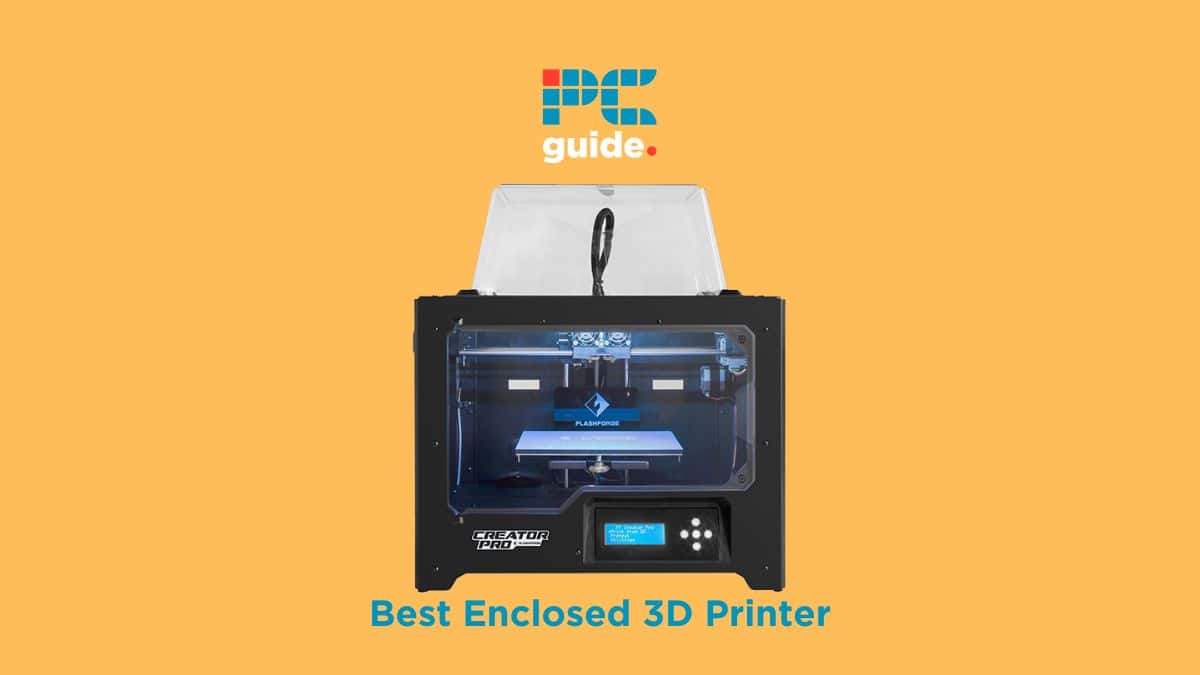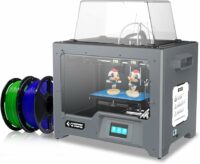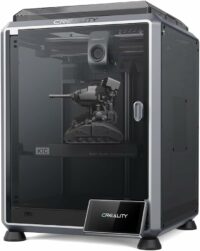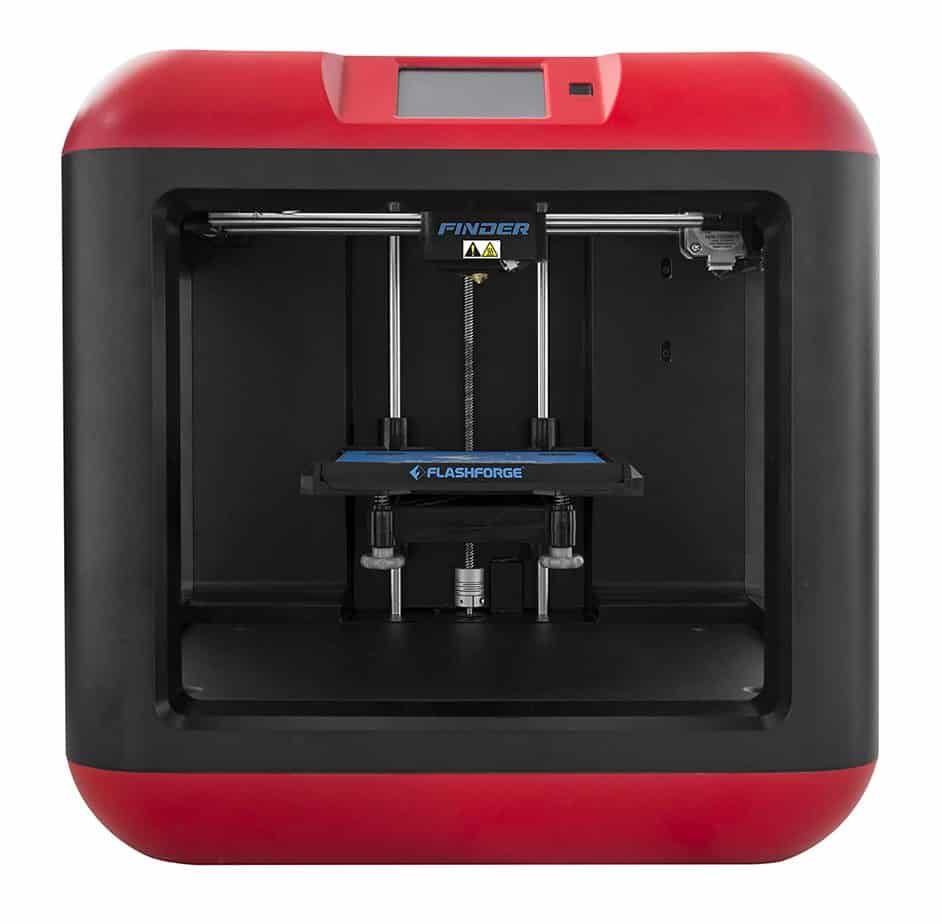Best Enclosed 3D Printer: Closed-Frame 3D Printers for Beginners

Table of Contents
3D printers are very noisy and cumbersome machines by their very nature, but a good way to mitigate that – and have a generally safer 3D printing environment for beginners – is to invest in one of the best enclosed 3D printers. These units may be more limited in build volume, but keep noise and potential fumes from the 3D printing process to a minimum, making them ideal for people working with limited spaces or smaller-scale projects.
We’ve compiled a guide of the best enclosed-frame 3D printers, so that buyers looking for a more manageable 3D print solution can find the right printer for their needs. Across a range of budgets and sizes, these enclosed printers cast a wide net, but are all valid claimants to the title of “best enclosed 3D printer”!
-
Editor’s Pick
FlashForge Creator Pro 2
- Build Volume: 300mm x 300mm x 325mm
- Filament: PLA, ABS, PETG, HIPS
- Connectivity Technology: USB
- Filetype: STL
-
Best Fast Enclosed 3D Printer
Creality K1C
- Build Volume: 220mm x 220mm x 280mm
- Filament: PLA, ABS, PETG, TPU, ASA, HIPS
- Connectivity Technology: USB, SD, WiFi
- Filetype: STL, OBJ, AMF
-
Best Budget Enclosed 3D Printer
FlashForge Finder
- Build Volume: 140mm x 140mm x 140mm
- Filament: PLA
- Connectivity Technology: USB, WiFI
- Filetype: STL, OBJ
-
Best Enclosed 3D Printer for Beginners
Monoprice Voxel
- Build Volume: 150mm x 150mm x 150 mm
- Filament: PLA, ABS, PETG
- Connectivity Technology: USB, WiFI
- Filetype: STL
-
Best Accurate Enclosed 3D Printer
QIDI Technology X-CF Pro
- Build Volume: 300mm x 250mm x 300mm
- Filament: PLA, ABS, PETG, Nylon, Carbon Fiber
- Connectivity Technology: USB, WiFI
- Filetype: STL
How We Picked the Best Enclosed 3D Printer
Of course, the primary qualifying factor in this ranking of the best enclosed 3D printers is that the printers are enclosed – but there are still many other distinguishing factors that separate them beyond that. We considered the standard array of 3D printer factors such as print speed, build volume and filament compatibility, along with additional elements such as auto-leveling or good print bed adhesion, to ensure that our choices were the best models available.
However, we then factored in the price points of the different models, accounting for a range of budgets. We settled on five products across the price range, each a highly worthwhile purchase, but only one can be the best enclosed 3D printer…

- Build Volume: 300mm x 300mm x 325mm
- Filament: PLA, ABS, PETG, HIPS
- Connectivity Technology: USB
- Filetype: STL
An absolute powerhouse of printing, the Creator Pro 2 is a stellar 3D printer contained within an innovative casing.
- IDEX systems – print with even more versatility thanks to the Creator Pro 2's dual extruders.
- Fast assembly – though not quite ready out-the-box, this 3D printer is easy to assemble.
- Loud – even with the closed frame, the Creator Pro 2 is still quite noisy when in operation.
The FlashForge Creator Pro 2 tops our ranking of the best enclosed 3D printers, thanks to an innovative dual extruder system implemented in a great design. If you want a highly versatile and useful 3D printer that doesn't take up much space, this is the ideal solution!
Though beginners may still struggle, assembling the Creator Pro 2 is quick and easy, with helpful instructions making the process more intuitive. At 200mm x 148mm x 150mm, this unit boasts a respectable build volume – though it's of course limited by the close-frame design. The aforementioned independent dual extruders (IDEX) allow for prints to be completed faster and even in multiple colors for even more design possibilities.
However, though enclosed frame printers are often less noisy than their open-frame contemporaries, the Creator Pro 2 is the exception to the rule. It's not deafening, but time around this 3D printer can be a literal headache. It's the only flaw in this otherwise phenomenal unit, and it doesn't stop the Creator Pro 2 from being the best enclosed 3D printer on today's list!

- Build Volume: 220mm x 220mm x 280mm
- Filament: PLA, ABS, PETG, TPU, ASA, HIPS
- Connectivity Technology: USB, SD, WiFi
- Filetype: STL, OBJ, AMF
Quick to set up and even quicker to print, the K1C is an absolute productivity powerhouse.
- No setup – the K1C comes out of the box ready to print.
- Fast printing – the dual z-axis extruder is capable of speeds up to 600mm/s.
- Inconsistent print bed – like with the K1 Max, you may struggle to retrieve your prints intact.
One of the more recent 3D printers on today's list, the Creality K1C is a tremendous printing solution for high-speed and high-quality prints. Creality are well-known for balancing quality and price, and this productivity powerhouse maintains that sterling tradition.
Ready right out of the box, there's no assembly required with the K1C at all. With a print volume of 220mm x 220mm x 250mm, this printer has great space to print without sacrificing the benefits of a closed-frame design. The print speed is as blisteringly high as 600mm/s, and the printer is compatible with a wide range of filaments – from olfactory favorites like PLA through to more niche options like carbon fiber.
However, one issue we've made mention of before is the poor print bed that this shares with the K1 Max: adhesion isn't always consistent, so you may struggle to retrieve your designs without damaging them, if you aren't careful. Still, for high speeds and highly varied print options, the K1C is a tremendous enclosed 3D printer!

- Build Volume: 140mm x 140mm x 140mm
- Filament: PLA
- Connectivity Technology: USB, WiFI
- Filetype: STL, OBJ
Easy to use, ideal for beginners, the Finder is a great entry-level 3D printer for a low price.
- Ships fully assembled – there’s no cumbersome assembly with this 3D printer.
- Affordable – thanks to its sub-$300 price tag, this is an inexpensive 3D print solution.
- PLA only – though the printer can accommodate PETG, the filament compatibility of the Finder is somewhat limited.
Consider the Flashforge Finder: a budget enclosed 3D printer from FlashForge that serves as a great entry point into 3D printing. For great-quality prints for a price tag under $300, this is a low-risk 3D printer that's barebones, but brilliant.
Like the K1C, this printer ships fully assembled to allow you to get started immediately. You've got a range of connections with the Finder: from USB through to WiFi, you can send your designs to the device quickly and easily. Print configuration is made easier thanks to the full-color touchscreen, and the results are precise between 100 and 500 microns of detail. At it's price point, this unit is a terrific starter 3D printer for those wanting to experiment without a heavy committment.
More experienced 3D print artists may find this unit a bit limiting, however. With compatibility restricted to PLA filament, you may find that you outgrow this unit once you start printing more confidently. Though as a starter printer, the FlashForge Finder is a tremendous enclosed 3D printer!

- Build Volume: 150mm x 150mm x 150 mm
- Filament: PLA, ABS, PETG
- Connectivity Technology: USB, WiFI
- Filetype: STL
The Voxel strikes a great balance between beginner-friendliness and printing complexity, making it an ideal choice for any age groups.
- Varied filament options – unlike the Finder, you’ll have plenty of filament to choose from with the Voxel.
- Customizable – tweak different components and settings to your heart’s content as you get to grips with this 3D printer.
- Small filament spools – you find yourself constantly refilling the Voxel’s filament mid-print with its small spool size.
If you need a compact and user-friendly enclosed 3D printer, then the Monoprice Voxel is the ideal solution. With a modest build size of 150mm x 150mm x 150mm, this unassuming unit does a lot with a little.
Employing premium features like automated leveling, the Voxel makes for an accessible and easy start to 3D printing. The print bed itself is flexible, which reduces the chance of your designs snapping when done. You've got a range of filament to choose from, including PLA and ABS, and for more intensive or specific 3D prints you can even quickly and easily swap out the print nozzles. All of this versatility and accessibility makes this 3D printer ideal for beginners, kids or anyone looking for a high-quality entry-level 3D printer that can scale with their skill level.
That said, though the filament selection is wide, the size of the spools is quite small. This is likely due to the limited build volume, but it does make for frequent and cumbersome refilling of the filament. Other than that, we highly recommend the Monoprice Voxel as a compact entry-level 3D printer!

- Build Volume: 300mm x 250mm x 300mm
- Filament: PLA, ABS, PETG, Nylon, Carbon Fiber
- Connectivity Technology: USB, WiFI
- Filetype: STL
If you require print quality above all else, then the X-CF’s highly precise extruder is what you’ve been looking for.
- Highly accurate – with print resolution as precise as 50 microns, details are rendered carefully in the X-CF Pro.
- Built-in camera – observe your print-in-progress with the X-CF Pro’s built-in camera.
- Slow print speed – rendering at a paltry 60mm/s, this 3D printer trades speed for precision.
With accuracy down to as little as 50 microns, the Qidi X-CF Pro is a premium 3D print solution. At the higher end of the price spectrum, close to $2000, this enclosed 3D printer is not for the faint of heart!
Employing a dual-gear extruder for high maneuverability and acceleration, the X-CF Pro is a fast and efficient 3D printer. You can use standard filaments such as PLA or ABS, but Qidi also stock specialty spools such as Nylon for varied prints. Once you've chosen your material, you can leave the enclosed 3D printer to get to work, and monitor the progress remotely thanks to an internal camera. Those print results are detailed, accurate and consistent.
One thing print results aren't, however, is fast. At 60mm/s, this printer lacks in speed what it makes up for in quality. If you want premium 3D prints, then the Qidi X-CF Pro is the ideal enclosed 3D printer for you!
Features and Considerations
There are a number of elements to consider that factor into choosing the best enclosed 3D printer for you. If you’re new to this market, here are some key tips on what to look out for:
Assembly
As evidenced by our top choices, one of the major benefits of 3D printing is that the units largely come pre-assembled. Still, if you want a printer up-and-running as quickly as possible, see what the manufacturer says about the complexity of the assembly process.
Build Volume
Build volume, measured in millimeters, tells you how large a theoretical space you have to design your 3D print. Though enclosed and small 3D printers are inherently limited in how large they can print, you also don’t want to have too large a printer if you’re only going to be working on small-scale prints.
Print Quality
Like with a 2D printer, the print resolution affects the overall quality and detail of your model. With the average 3D printer, this should be within fractions of a millimeter. Whilst this may sound unnoticeable, bear in mind that low resolutions will be more notable on miniatures and other small-scale prints – the devil’s in the details!
Filament
There are a wide range of filaments on the market that each suit different purposes – from standard materials like PLA, to food-safe filaments to make cookie cutters or other utensils, through to even wood or metal filaments. Depending on your print project, make sure you have the right enclosed 3D printer for the best compatibility!
Print Speed
If you are operating a small business or in an environment that necessitates fast turnarounds, print speed is crucial. A 3D printer’s extruders print in millimeters per second: the faster the speed, the quicker you’ll have your prints (not to be confused with “acceleration”, which is how effectively the extruders change direction). Similarly, you don’t want long heat-up times for the print bed, as this can eat into valuable time.
Open-Frame vs Closed-Frame: Which are the Better 3D Printers?
3D printers are generally either open-frame or closed-frame in design, with some exceptions towards the industrial-grade end of the market. Enclosed 3D printers like the ones on today’s list are smaller on average, with limited build volumes which can hamper creativity for ambitious 3D print projects. However, they are generally quieter and safer: keeping noise and fumes from the heated filament contained within the chamber.
Open-frame printers, on the other hand, can print larger models within the same space, and are capable of more varied and unique designs. However, they can also be more expensive at the higher end, and difficult to house if you are working with limited space. If you are working with filament that requires high heat, they are also naturally hotter and more expensive to run.
We generally recommend closed-frame printers for hobbyists and beginners, and open-frame models to businesses or those with more varied and interesting designs.
The third type of 3D printer, the SLA Printer – or Resin 3D printer – utilizes a closed shell and laser to cut the material from a liquid-like resin. These are a good middle ground between the two: capable of creating unique pieces, but only out of resins. They are popular among cosplayers for their relatively low running costs and ease-of-use.
FAQs
A slicer is a piece of software that allows a 3D printer to translate a CAD design. Different slicers have different file compatibilities, so double-check yours is suitable for your choice of design software.
Depending on the model, enclosed 3D printers can be heavier than their open-frame counterparts – having a larger footprint. The best enclosed 3D printers use their frames to reduce vibrations and print errors, though this makes them more cumbersome.
Verdict

- Build Volume: 300mm x 300mm x 325mm
- Filament: PLA, ABS, PETG, HIPS
- Connectivity Technology: USB
- Filetype: STL
Though it’s noisier than its counterparts, the FlashForge Creator Pro 2 combines quality, affordability and versatility into one package – making it our top pick for the best enclosed 3D printer! The IDEX system makes for fast and detailed results, with terrific compatibility and accessibility for beginner and journeyman 3D printers alike!
Looking to create more accurate models? Check out our guide on the best 3D scanners, enabling you to turn real-world objects into CAD-friendly scans!